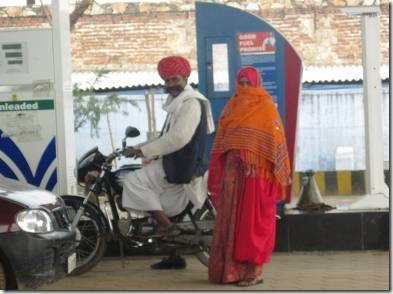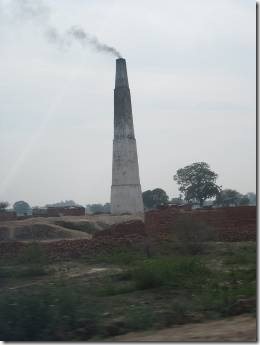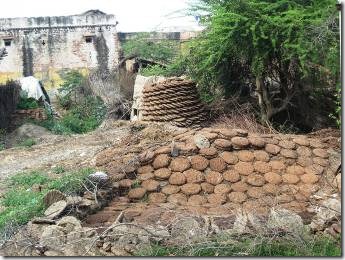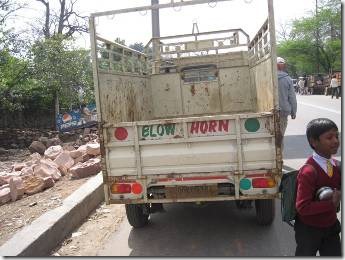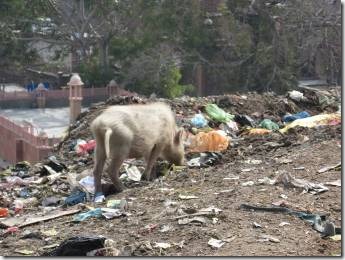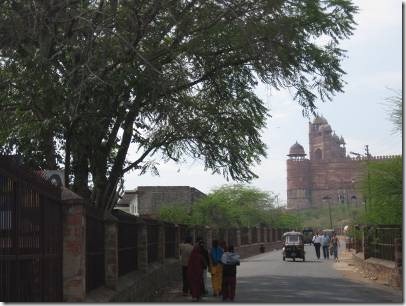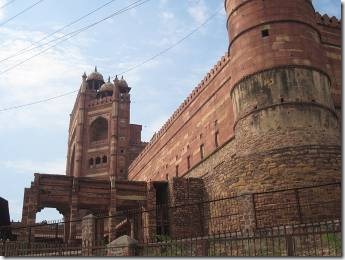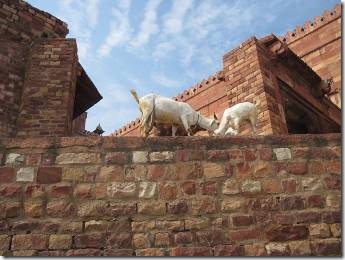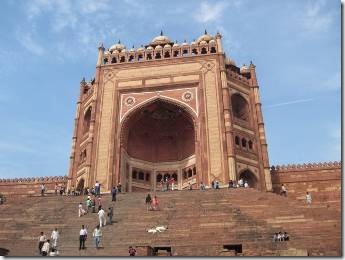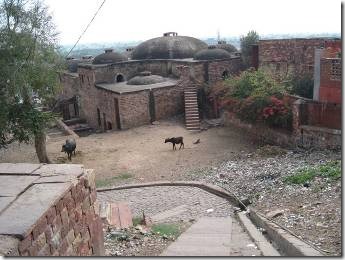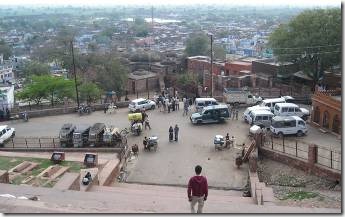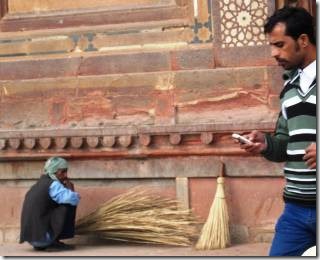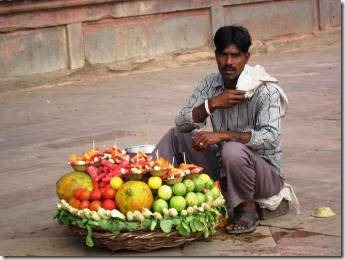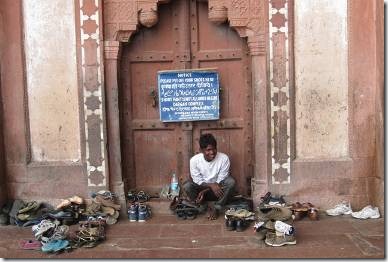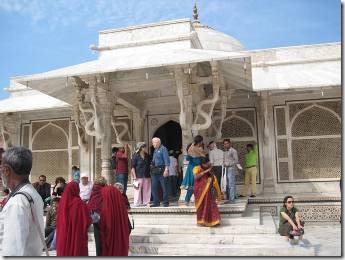On our way to Agra to see the Taj Mahal we stopped in Fatehpur Sikri. It was either on Linda’s list of things to see, or was suggested by our tour man, Nayeem; but I knew nothing about it. The fort complex charged a fee but the Mosque was free so Linda, Michael and I opted for the Mosque and Randal opted to stay in the car with Sandeep. We had no “local guide” though one man did attach himself to me in hopes that I would buy something from his friends. I listened to what he had to say about the Mosque but didn’t buy anything because I didn’t want to deal with the whole sales pitch bargaining ritual and I really didn’t want anything right then. If you could just walk around and browse, I think I might buy more than having to deflect all of the sales pitches especially from the small boys selling post cards. Actually I wish I had bought some of the post cards but if you ask to look you’re besieged with other kids selling their post cards…but the boys all were such good salesmen with excellent English skills and most were probably younger than 12. It was like being surrounded by knats, but cute friendly knats.
Though obviously not as stunningly beautiful as the Taj Mahal, there was something splendid about the Fatehpur Jami Mosque. Maybe the steps leading up to it or the sheer size of the entry gate, but it was truly impressive. There was no local guide and I hadn’t read the small bits in Linda’s India guide so I really knew nothing and missed quite a bit. But, even knowing nothing, it was easy to be impressed. Unfortunately, since we still had to continue on to Agra and try to see the Taj Mahal at sunset, we really didn’t have so much time.
“Jami Masjid or the Friday Mosque is one of the most beautiful and largest mosques of the world. This elegant building is the most sacred building and the principal mosque of the town and thus situated on the highest point of the ridge where Fatehpur Sikri is situated. In fact, the Buland Darwaja commemorating the victory of Akbar over Deccan and the Tomb of the famous Sufi Saint Sheikh Salim Chishti are a part of this spacious mosque complex. Built in the supervision of the saint himself and his descendants, it was completed in 1571. http://www.agraindia.org.uk/fatehpur-sikri/monuments/jami-masjid.html "
http://whc.unesco.org/en/list/255 for more info
On our way to Fatehpur we stopped for fuel as did this couple on their motorbike.
I tried to sneak the photo but they obviously caught on. If we hadn’t been ready to leave I would have gone over and actually asked so I could have captured his wonderful huge moustache and turban and her lovely bright sari.
We passed dozens of brick kilns some with white smoke and some with black.
Cow pats are used in India just as they were in Tibet.
Blow Horn was written on the back of almost every truck we saw: as if other drivers needed to be told.
Everyone honks all of the time so it’s a wonder anyone pays attention to horns and it’s so loud. Every now and then a truck had a horn like a clarinet and that was fun to hear. As Sandeep told us to drive you need three things: A good horn, good breaks, and a good driver. Did I mention that already? But when we passed motorbikes and Sandeep blared the horn I thought how much I would hate that if people did it to us as we rode our motorbike.
Garbage pigs of Fatehpur.
In Cochin the herds of wandering goats eat the trash. Up north, it was pigs. The first ones we saw in Delhi were a mother and 3 piglets in the alleyway near our hotel. They just ignored humans and went about their business of eating. Not sure what eventually happens to them or if they belong to anyone.
Walking towards the Mosque.
Sandeep knew we would be besieged by local men wanting to act as guides so pretended to drive past the entrance to the Fatehpur Sikri complex but then did a great fake out and turned in to the parking lot. As it was we had several small boys who wanted the job and who followed us half way on the half mile walk to the Mosque before giving up.
It was massive.
Buland Darwaza
“Buland Darwaza was built by the Mughal emperor Akbar in 1602 A.D. to celebrate his victory over Gujarat. This huge and magnificent structure is situated on the southern wall of the mosque, Jama Masjid. It is about 54 meters in height and is also considered as the highest gateway of the world. Serving as the main entrance to Fatehpur Sikri, it is referred as the ‘the gateway of magnificence’ by historians. “ http://www.indiacitytrip.com/Uttar-Pradesh-Destinations/places-to-see-in-fatehpur-sikri.aspx It looked a long way but not so many steps as the Philadelphia Art Museum. Does anyone walk up stairs like these and not think of “Rocky?”
Looking down the steps back into the middle ages…
A broader shot takes us back to the 21st century.
Another mix or centuries…
The fruit looked tempting but we were warned about street food in India…too bad but even the water food was washed in became something to consider.
Shoes had to be removed and for a fee this young man would guard them. Most places like the temple in the Amber Fort complex, no one would bother them anyway. We carried our shoes most of the way, but at one point we were told even carrying our shoes wasn’t allowed so Michael volunteered to watch our shoes as Linda and I went into the tomb of the Sufi Saint.
The tomb of Sufi Saint Sheikh Salim Chishti
Next email, part 2
Ru
DoraMac

